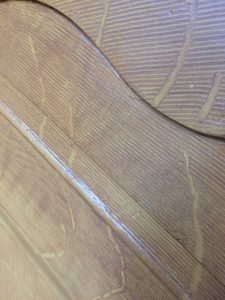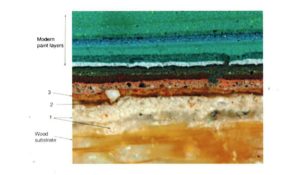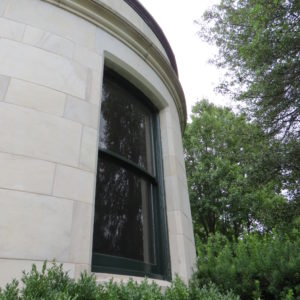A year after first beginning, a project on the doors and windows of the Robert H. Smith Visitor Education Center concluded this month. Read Preservation Manager Jeff Larry’s account of how we determined what colors to paint the trim, the challenges of faux graining, and why the Visitor Education Center does not represent any particular time period.
A restoration project that began last summer on the Visitor Education Center’s exterior trim and doors was completed earlier this month by J.E.K. Painting and Sage Craftsmen. All 27 double-hung sashes on the first floor were removed and received minor repairs primarily to the lower rail. This includes the three sashes in the orientation room that are nearly eight feet tall and, because the room is round, have curved glass! Also restored were the forty casement windows on the second floor and all the sills and trim work.
As the work progressed we were frequently asked how we determined which color to use. A paint analysis from 2013 revealed that all of the exterior trim and sash were originally faux grained to look like white oak, which is similar to the graining found inside the Cottage.

An example of faux graining meant to imitate white oak taken from the Cottage stairs. All of the exterior woodwork on the Visitor Center was originally faux grained and probably looked similar to this.
Exterior graining can be difficult to maintain and the report shows the next color was a shade of dark brown. Following the brown layer it appears that for the next 80-90 years nearly all of the paint layers were varying shades of green.

Matthew Mosca’s 2013 paint analysis showing the layers of paint found on the Visitor Education Center exterior trim. The lowest layer is the wood substrate (1) followed by the basecoat and graining coat (2) followed by the base and brown coat (3) Then lots of greens.
Unlike the Cottage, which is painted to appear as it did in Lincoln’s time, we were not attempting to present the Visitor Education Center as representing any particular time period. This is because the work that was completed in 2008 to transform the Visitor Education Center from its original use as the Soldier’s Home Administration Building was classified as a “Rehabilitation.” According to the Secretary of the Interior’s Standards for the Treatment of Historic Properties, rehabilitation is defined as:
“the act or process of making possible a compatible use for a property through repair, alterations, and additions while preserving those portions or features which convey its historical, cultural, or architectural values. The Rehabilitation Standards acknowledge the need to alter or add to a historic building to meet continuing or new uses while retaining the building’s historic character.”
Thus, with its long history of green paint and in an effort at “retaining the building’s historic character” we chose to apply Benjamin Moore’s “Essex Green.”

